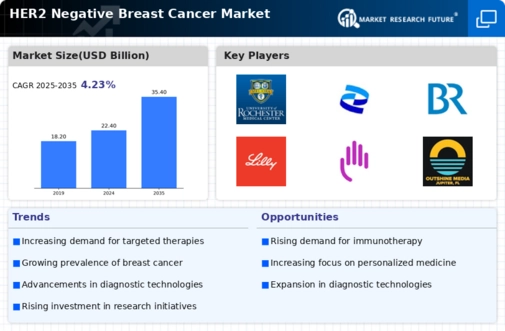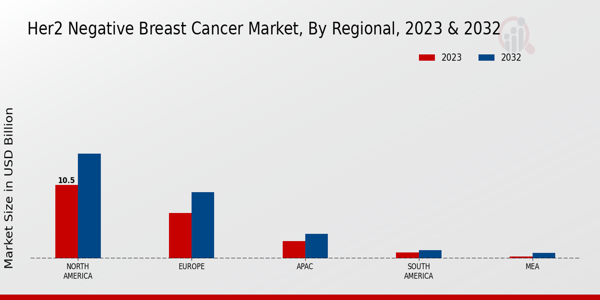Market Growth Projections
The Global HER2 Negative Breast Cancer Market Industry is poised for substantial growth, with projections indicating a market value of 22.4 USD Billion in 2024 and an anticipated increase to 35.4 USD Billion by 2035. This growth trajectory suggests a compound annual growth rate of 4.23% from 2025 to 2035. The market dynamics are influenced by various factors, including advancements in treatment options, increased awareness, and ongoing research efforts. As the industry adapts to these changes, stakeholders are likely to witness a robust expansion, reflecting the urgent need for effective solutions in the fight against HER2 negative breast cancer.
Advancements in Targeted Therapies
Advancements in targeted therapies are significantly influencing the Global HER2 Negative Breast Cancer Market Industry. Recent developments in treatment modalities, such as hormone receptor-targeted therapies, have shown promise in improving patient outcomes. For instance, the introduction of CDK4/6 inhibitors has transformed the treatment landscape, providing new options for patients with advanced disease. These innovations are likely to enhance the efficacy of existing treatments, thereby increasing patient survival rates. As a result, the market is anticipated to grow, with projections indicating a value of 35.4 USD Billion by 2035, driven by the ongoing evolution of therapeutic strategies.
Growing Awareness and Screening Programs
The Global HER2 Negative Breast Cancer Market Industry is benefiting from heightened awareness and screening initiatives aimed at early detection. Public health campaigns and educational programs have increased knowledge about breast cancer symptoms and the importance of regular screenings. This proactive approach is likely to lead to earlier diagnoses, which can improve treatment outcomes. Furthermore, as more individuals participate in screening programs, the demand for diagnostic tools and services is expected to rise. This trend aligns with the projected market growth, as the industry adapts to meet the needs of a more informed patient population.
Increasing Investment in Cancer Research
Investment in cancer research is a crucial driver for the Global HER2 Negative Breast Cancer Market Industry. Governments and private organizations are allocating substantial funds to explore novel treatment options and improve existing therapies. This financial support is likely to accelerate the development of innovative drugs and technologies, enhancing the overall treatment landscape for HER2 negative breast cancer. As research initiatives progress, the market is expected to witness significant advancements, potentially leading to a compound annual growth rate of 4.23% from 2025 to 2035. This sustained investment underscores the commitment to addressing the challenges posed by this disease.
Emerging Biomarkers and Personalized Medicine
The emergence of biomarkers and the shift towards personalized medicine are reshaping the Global HER2 Negative Breast Cancer Market Industry. Biomarkers play a pivotal role in identifying patients who may benefit from specific therapies, allowing for more tailored treatment approaches. This trend is likely to enhance the precision of interventions, improving patient outcomes and minimizing adverse effects. As research continues to uncover new biomarkers, the market is expected to evolve, with a growing emphasis on personalized treatment strategies. This evolution may contribute to the overall growth of the industry, aligning with the increasing demand for individualized care.
Rising Incidence of HER2 Negative Breast Cancer
The Global HER2 Negative Breast Cancer Market Industry is experiencing growth due to the increasing incidence of HER2 negative breast cancer. Statistics indicate that approximately 70-80% of breast cancer cases are classified as HER2 negative. This rising prevalence is likely to drive demand for innovative treatment options and diagnostic tools. As healthcare systems worldwide adapt to this growing challenge, investments in research and development are expected to increase. This trend is projected to contribute to the market's expansion, with an estimated value of 22.4 USD Billion in 2024, reflecting the urgent need for effective therapies and supportive care.
























Leave a Comment